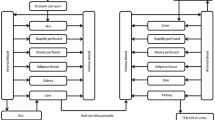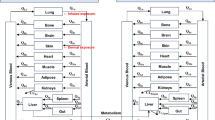Abstract
Objective: The methods and results are described of a study on the dermal absorption of chlorpyrifos (CPF) in humans established via urinary excretion of the metabolite 3,5,6-trichloro-2-pyridinol (TCP). Methods: Two dermal, single, doses of CPF were applied in two study groups (A and B) each comprising three apparently healthy male volunteers who gave their written informed consent. The clinical part of the study was conducted in compliance with the ICH Guideline and the EC principles of good clinical practice (GCP). An approximately 0.5 ml dilution of CPF in ethanol was applied to an area of ~100 cm2 of the volar aspect of the forearm, resulting in doses of either 5 mg (A) or 15 mg (B) of CPF per study subject. Duration of dermal exposure was 4 h, after which the non-absorbed fraction was washed off. The following samples were collected at pre-determined intervals for the determination of either CPF or its metabolite TCP: dosing solutions, wash-off fractions and urine samples collected up to 120 h after dosing. Results: A relatively large fraction of CPF (42%–67% of the applied dose) was washed off from the exposed skin area. Application of either 5 mg (A) or 15 mg CPF (B) resulted in the total urinary excretion of 131.8 μg (A) or 115.6 μg (B) of TCP 120 h after dosing. This indicated that 4.3% of the applied dose has been absorbed (A), while in group (B) no significant increase in urinary TCP (115.6 μg) was established. The latter indicates that an increase in the dermal dose at a fixed area does not increase absorption, which suggests that the percutaneous penetration rate was constant. Further, it was observed that the clearance of CPF by the body was not completed within 120 h, suggesting that CPF or TCP was retained by the skin and/or accumulated in the body. A mean elimination half-life of 41 h was established. Conclusion: The results show that daily occupational exposure to CPF may result in accumulation of CPF and/or its metabolites, possibly resulting in adverse effects.




Similar content being viewed by others
References
ECETOC (1993) Percutaneous absorption, monograph no. 20. European Centre for Ecotoxicology and Toxicology of Chemicals (ECETOC). Brussels, Belgium
EXTOXNET (1996) Pesticide information profiles. Chlorpyrifos (revised)
Feldman RJ, Maibach HI. (1974) Percutaneous penetration of some pesticides and herbicides in man. Toxicol Appl Pharmacol 28:126–132
Griffin P, Mason H, Heywood K, Cocker J (1999) Oral and dermal absorption of chlorpyrifos: a human volunteer study. Occup Environ Med 56:10–13
Griffin P, Payne M, Freedlander E, Curran AD, Cocker J (2000) The in vitro percutaneous penetration of chlorpyrifos. Hum Exp Toxicol 19:104–107
Hines CJ, Deddens JA. (2001). Determinants of chlorpyrifos exposures and urinary 3,5,6-trichloro-2-pyridinol levels among termiticide applicators. Ann Occup Hyg 45:309–321
Jung CT, Wickett RR, Desai PB, Bronaugh RL (2003) In vitro and in vivo percutaneous absorption of catechol. Food Chem Toxicol 41:885–895
Krieger RI, Bernard CE, Dinoff TM, Roxx JH, Williams RL (2001) Biomonitoring of persons exposed to insecticides used in residences. Ann Occup Hyg 45:S143–S153
Meuling WJA, Bragt PC, Leenheers LH, de Kort WLAM (1991) Dose–excretion study with the insecticide propoxur in volunteers. In: Scott RC, Guy RH, Hadgraft J, Boddé HE (eds) Prediction of percutaneous penetration. Methods, measurements and modelling, vol 2, pp 13–19
Meuling WJA, Opdam JJG, de Kort WLAM. (1993) Dose excretion study with the fungicide carbendazim in volunteers. In: Scott RC, Guy RH, Hadgraft J, Boddé HE (eds) Prediction of percutaneous penetration. Methods, measurements and modeling, vol 3, pp 598–603
Nolan RJ, Rick DL, Freshour NL, Saunders JH. (1984) Chlorpyrifos: pharmacokinetics in human volunteers. Toxicol Appl Pharmacol 73:8–15
Reddy MB, Guy RH, Bunge AL (2000) Does epidermal turnover reduce percutaneous penetration? Pharm Res 17:1414–1419
Ross JH, Dong MH, Krieger RI (2000) Conservatism in pesticide exposure assessment. Regul Toxicol Pharmacol 31:53–58
Yourick JJ, Koenig ML, Yourick DL, Bronaugh RL (2004) Fate of chemicals in skin after dermal application: does the in vitro skin reservoir affect the estimate of systemic absorption? Toxicol Appl Pharmacol 195:309–320
Acknowledgements
All study subjects are gratefully acknowledged for their dedicated participation and their never-ending confidence in the study team. The support and technical assistance of Lambert Leenheers, Berry Wezendonk and Mrs. Usha Soekhoe, and the help of Arie A. Vink in the preparation of this manuscript, are gratefully acknowledged. This study was financially supported by the Netherlands Ministry of Social Affairs and Employment under project no. 41621.
Author information
Authors and Affiliations
Corresponding author
Rights and permissions
About this article
Cite this article
Meuling, W.J.A., Ravensberg, L.C., Roza, L. et al. Dermal absorption of chlorpyrifos in human volunteers. Int Arch Occup Environ Health 78, 44–50 (2005). https://doi.org/10.1007/s00420-004-0558-6
Received:
Accepted:
Published:
Issue Date:
DOI: https://doi.org/10.1007/s00420-004-0558-6




